Menus
- The best, quite simply
- 998 cc V4, 221 hp (234 hp) and 112 Nm, electronics and ride-by-wire, aerodynamic fairing, 193 kg full facts, 39,900 euros
- Discovery
- In town, on the motorway and on departmental roads
- On circuit
- Cycle part
- Brakes
- Embedded electronics
- Conclusion
The best, quite simply
998 cc V4, 221 hp (234 hp) and 112 Nm, electronics and ride-by-wire, aerodynamic fairing, 193 kg full facts, 39,900 euros
2019 represents a pivotal year for Ducati in competition and even for Superbike races in general.. For the first time in 31 years and the creation of the World Superbike Championship in 1988, there will be no Ducati V-Twins on the grid when the season begins at Phillip Island in February. Indeed, for the first time, there will no longer be a single twin-cylinder motorcycle and all the motorcycles on the grid will be equipped with a one-liter engine for the first time since 2008, when the FIM raised the capacity ceiling for twins to 1,200 cm3 against 1,000 cm3 for the 4 cylinders.
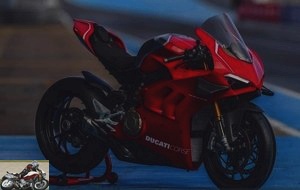
It was because Ducati put an end to its desmo V-Twin sports lineage dating back to 1972 that Paul Smart won the Imola 200 for the first race with a desmodromic 750 V-Twin. 14 Superbike World Champion titles later, the last prize was won in 2011 by Carlos Checa on a 1098R, Ducati finally decided to produce a four cylinder model for Superbike racing relying on his MotoGP Desmosedici V4, introduced as for him since 2002 and whose last version allowed Andrea Dovizioso to finish twice vice-champion of the MotoGP World behind Marc Marquez and Honda.
The Desmosedici Stradale technology had already been introduced to the market a year ago with the Panigale V4 S, but with a 1.103 cc engine ineligible for the WorldSBK. But at the last EICMA show in Milan, Ducati unveiled its very first 4-cylinder road-oriented superbike! Because to be able to ride in the championship, a motorcycle must be fully homologated and produced at a minimum of 125 units before its first racing season, 250 at the end of the first and 500 at the end of the second. The machines must also respect a price limit of 40,000 euros. Thus, the V4 R of 998 cm3 appears at 39,900 euros including tax.
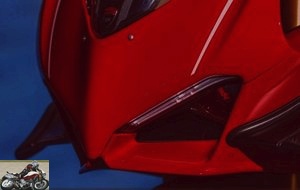
To ensure that enough motorcycles will have been produced before the season kicks off on the last weekend of February, production began in January. We even saw it on the assembly lines when we visited the factory in Bologna..
Discovery
This is the most powerful motorcycle ever produced by Ducati with a power of 221 horsepower at 15,250 rpm in the road version, i.e. 2,250 rpm higher than the 214 horsepower of the V4 S, with a torque of 112 Nm. at 11,500 rpm (against 124 Nm at 10,000 rpm for the 1.103 cm3 V4). The engine speed reached 16,500 rpm on the last gear and 16,000 on all the others..
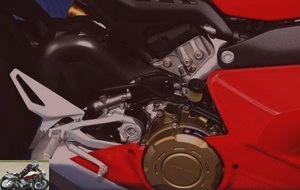
This is for the road version, because in track configuration with its Akrapovic exhaust system, the power goes up to 234 horsepower for a weight of 193 kg with the full water, oil and the aluminum tank of 16 liters filled (or 172 kg dry). The incredible power-to-weight ratio reaches 1.36 horsepower per kilogram, very close to the 1.38 hp / kg of the 1299 Supperleggera (215 hp) which remains the benchmark on all road models produced to this day. But unlike its Superleggera which has only 500 copies, Ducati does not consider the V4 R as a limited edition and intends to produce at least 1,000 copies in 2019 alone..
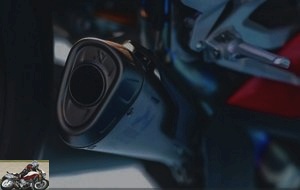
All the fairing has been redesigned and we see here pushing fins on the sides. They are derived from the winglets used by Ducati in MotoGP in 2016 before the regulations were changed to make them less visually intrusive (or less dangerous) although apparently less functional. The wind tunnel-tuned aerodynamics also feature a more curved and taller 34mm screen to enhance rider protection, although I have to admit I only spent a maximum of 4 seconds per lap behind him on the twisty. Jerez circuit. Aragon or Phillip Island would be another matter. The redesigned fairing also includes large gill-like openings in each sidewall to allow the radiators to dissipate their heat more efficiently. The intake openings in the nose of the fairing are much larger than on the V4 S for deeper breathing at higher revs. Form follows function.
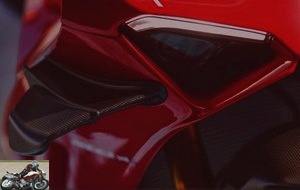
The V4 R’s shortened double-spar frame uses the same so-called "Front Frame" design as on the S, but with less metal behind the steering column to provide more flexibility, in other words "optimized rigidity" (the rules of the WSBK allow the addition of materials to the frame, but no removal). This is important for Chaz and Alvaro, less for us, so it was not so tragic that the test bikes were not yet equipped with this frame configuration which has not yet been produced in large quantities. The geometry remains the same between the two, the only difference is in the degree of bending and, of course, in a small amount of weight. The understated cast aluminum single-sided swingarm offers a wheelbase of 1,471mm, although the V4 R likes hard acceleration. Swingarm pivot can now be adjusted to 4 positions in 2mm increments.
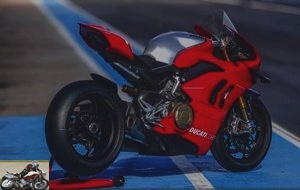
The Ohlins Smart EC 2.0 suspension of the V4 S disappears here from the package because electronic suspensions are prohibited in WSBK. Instead, the V4 R comes equipped with a mechanically adjusted and lighter 43mm TIN coated Ohlins NPX 25/30 inverted fork that combines well with the TTX-36 rear shock to provide great confidence and confidence. a real feeling of agility that I did not expect. After having had the chance to test all the factory WSBK machines between 1988 and 2015, the almost delicate handling of the new Ducati reminded me of the way the Honda RC45 Castrol 750 rode with which John Kocinski had won the world title. in 1997. The previous Japanese 90 ° V4 combined two often mutually exclusive traits, agility and stability and this is what the similarly formatted Ducati V4 R also offers, but in a much more powerful package. Despite the long wheelbase, the V4 R is thus easier to change direction than any other desmo V-Twin Superbike that I have been able to ride..
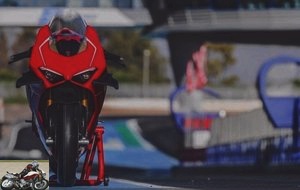
Only a few weeks after the presentation of the EICMA, Ducati invited a dozen privileged people from all over Europe to join its WSBK riders Chaz Davies and Alvaro Bautista to spend a day riding the bike on the Jerez circuit under the sunny southern Spain. In any case, that was the idea, because the day started with rain, mist and a wet track! But shortly after noon the circuit quickly dried up and I was able to do 35 laps in the V4 R, each time being a little more impressed by it. This is a motorcycle !
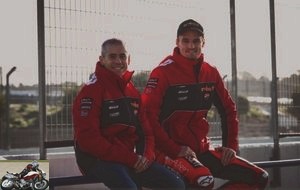
In town, on the motorway and on departmental roads
Although it breathes through four gigantic elliptical throttle bodies (56mm diameter), the Desmo V4 R engine is extremely manoeuvrable, if not friendly in the way it delivers power. You can honestly imagine driving this bike for shopping because it pulls so cleanly at low revs, barely above idle at 1,500 rpm, smoothly in the transmission and without needing to push too hard to use the engine. ‘dry slip clutch. Unfortunately, we did not have the opportunity to put the wheels of this Italian monster on the open road to detail its behavior a little more. So head to the circuit for serious matters.
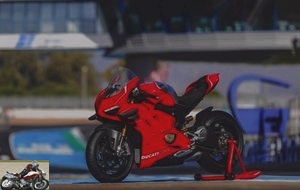
On circuit
While sharing the same technical base of the more down-to-earth, yet high-performing V4 S, this is truly a very different bike. First of all thanks to the engine, with its shorter stroke of 48.4 mm against 53.5 on the S, offers more appetite in the revs even before the adoption of a counter-rotating crankshaft in forged steel which is lighter by 1.1kg, titanium connecting rods and 34mm intake valves. This not only makes it possible to raise the rev limit at the switch placed at 16,500 rpm, but also to allow the V4 R to accelerate more quickly and to get out of curves more quickly. It is helped by the same double ignition as on the Desmosedici GP16 obtained by a crankpin offset at 70 ° and a cylinder angle of 90 °, the two left cylinders pulling practically together followed by the two right cylinders with an ignition order. 0 °, 90 °, 290 ° and 380 °. The sound of the V4 R is similar to that of the MotoGP with the same high, deep roar from both exhausts.
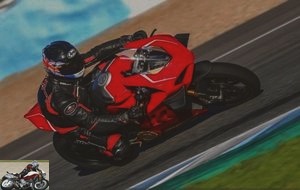
The power increases in a totally linear fashion to just over 8,500 rpm, while 80% of the torque is already available, halfway through the red zone, things then start to pick up speed. This "little" V4 engine catapults you even faster than its big sister V4 S while offering an extremely wide power range, meaning you stay in 2nd and 3rd gear on long stretches of the Jerez track there. where Chaz Davies claims to only use 4 of the 6 gears on his racing bike.
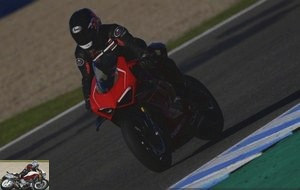
The shifter works naturally without disengaging in either direction, although I had to remember to be energetic enough to select the lower gear of Curva Lorenzo’s slow hairpin turn into the straight. There I ran into a false neutral going from second to first half a dozen times, but maybe the problem will be less present on a higher mileage box. Either that or use 2nd gear like Chaz told me he did. Yes, but… !
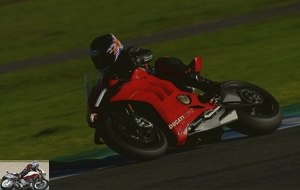
From 13,000 rpm, the variable-length intake horns lift up to shorten the intake tracks, so the higher-stroke camshafts can begin to do their job. Honestly, you never feel that transition. And yet, knowing that it was there, I looked well! But there is no feeling at this level. Instead, the speed and power generated by the revs are constant, especially thanks to the Akrapovic titanium exhausts mounted on the 4 test machines we had available. I presume the configuration with the Euro4 homologated exhaust is even easier in its operation. What’s more, I was in race mode, one of the three options available with Sport and Street which also offer all the power available, but with different degrees of response..
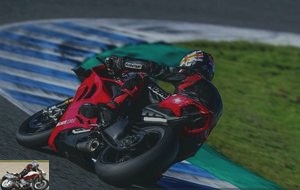
The V4 R engine quickly picks up speed, firing irresistibly more than explosively, but with a keen sense of task, until an orange gearshift indicator light appeared at the top left of the same TFT screen. 5 inches than that of the V4 S at 14,500 rpm, then a red on the right at 15,000. The high revs are made possible by the absence of valve springs on this desmodromic engine, allowing a more drastic camshaft design to be used alongside the lightweight internals and reducing the friction of elements such as forged aluminum pistons offering a compression ratio of 14: 1; another reason for the very strong recoveries at the end of the curve.
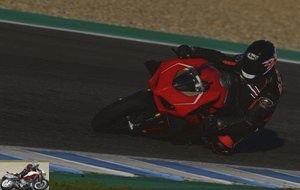
When you reach the breaker at 16,000 rpm, there is no sudden cut-off: the digital throttle simply lowers and stops pulling. The response to the grip is immediately and well felt on the rear tire, here mounted on a Pirelli slick. Despite the extreme power and performance, this is a very controllable bike with perfectly managed power, even when it starts to get excited on the racetrack..
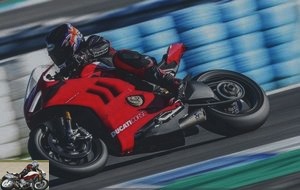
Cycle part
The new Ducati holds its trajectories really well, even on sharp acceleration. Although without any chicane (hurray!), Jerez is not an ideal circuit for testing a motorcycle’s ability to go from angle to angle very quickly, except at turns 2 and 3, where it seemed to both agile and responsive to driving.
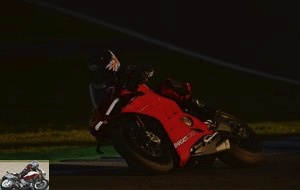
With a slightly softer front end and a stiffer rear spring than on the S, the R Model’s Ohlins suspension package offers impressive stability and exceptional feedback. There is a huge sense of response from the front which gives you extra confidence to maintain speed when going through curves. And thanks to the mass bias of 54/46% this also applies in hard braking.
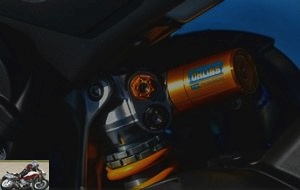
You can feel with your fingertips how well the front Pirelli grips the asphalt, a confidence it also owes to the fins mounted on the front of the fairing. The latter make it possible to provide greater downforce on the front wheel at high speed (16 kg at 200 km / h, 30 kg at 270 km / h) without this affecting top speed. They undoubtedly play an important role in optimizing front tire grip AND rider confidence. When you straighten up to brake before a turn, you can then see them coming out of the new fairing design, even though it is 38mm wider on each side than on the V4 S.
Brakes
The large 330mm twin discs and the lightest Brembo Stylema 4-piston monoblock radial calipers do a phenomenal job of bringing the bike to a halt at high speeds, but with plenty of control and without brutality. There is also a good degree of engine braking left in the clutch settings. All this brings the confidence to keep speed in curves as in the steep right turn, named after Sito Pons, who takes third..
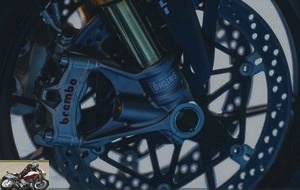
Embedded electronics
The Bosch electronic package of the V4 R, equipped with a 6-axis IMU control unit, includes everything from the stopwatch to the start control, including cornering ABS and pit lane limiter (adjustable in 40 and 80 km / h and which allows you to avoid fines when crossing towns and villages), wheeling control, DTC EVO traction control, DSC slip control, EBC engine brake control…
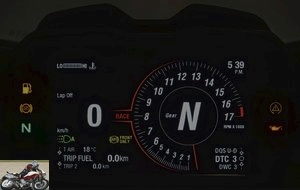
DWC could work better though. I did indeed encounter a few big wheelies when going from 2nd to 3rd gear, but the DTC is particularly effective, repeatedly intervening gently, but effectively during a session where the rear Pirelli had started to wear out. after countless lap times. Ducati has a lot of experience on how to map this correctly and it shows.
Conclusion
Ducati also has a lot of experience in designing a superbike with headlights. It’s the latest and in a way it’s the best yet.
I’m not a guesser, but I predict all the same and that despite the high price, Ducati will easily sell more than 1,000 copies of the V4 R. If not, just wait for BMW to produce a comparable M version of its new S 1000 RR with a boosted engine for the WSBK and all the carbon fiber M parts already on offer. Except that the Ducati V4 R is already there and offers a level of homologated performance for the road unmatched from a production motorcycle. Start saving now !
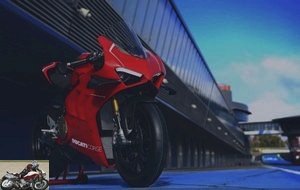
Strong points
- Motor
- Agility, precision and stability
- Quality of suspensions and braking
- Striking design
- A real road Superbike
Weak points
- High tariff in absolute terms
- Anti-wheeling management
- Shift a little hard when downshifting
The technical sheet of the Ducati Panigale V4 R
Related articles
-
Ducati 350 SCD motorcycle test
From the circuit to the road for the Italian sportswoman 4-stroke single cylinder, 340 cc, 42 hp, 210 km / h, 112 kg dry In 1954, the arrival of Fabio…
-
Fine-tuning in order You don’t change a recipe that works. The second generation of the Ducati Diavel therefore evolves only on points of detail while…
-
Biker test: Slow Philou At the house of Ducati, ST stands for Sport-Touring. The motorcycle was released in 1997 and has since that on points of detail,…
-
Ducati Multistrada 950 S motorcycle test
Time concordance A few generations of bikers have dreamed of the ultimate bike, one that adapts to context and mood, needs and desires. As our ancestors…
-
Ducati Streetfighter 848 motorcycle test
Fighting call girl At the end of 2008, Ducati undressed its sporty 1098, offering a muscular roadster with a radical design. Thus was born the…
-
Ducati Panigale V4 S motorcycle test
The price of the exception V4, 1103 cm3, 214 hp and 124 Nm, 195 kg all full facts, 28,890 euros The bike that was being born was obviously exceptional:…
-
Ducati 1098 motorcycle test – 160 hp in free version
There are times in a biker life where the emotional strikes, in the heart ! I remember when the 916 was released : what a slap! A stroke of genius signed…
-
Ducati Monster 620 motorcycle test
Biker testing: Garfield Ducati and me, it’s a long platonic love story. Between in high school in the late 80s, the teenager I was did not fail to swoon…
-
Ducati Monster motorcycle test
Salon revolution V-Twin Testastretta of 937 cm3, 111 hp, 93 Nm, 166 kg dry (188 kg full made), 11,290 euros Is a Monster still a Monster if it doesn’t…
-
Sports test Ducati 750SS Moreparts
The Desmo of Mike Hailwood’s comeback 90 ° desmo V-Twin, 749 cm3, 73 hp, 180 kg dry Most road racing enthusiasts will tell you that Mike Hailwood did not…